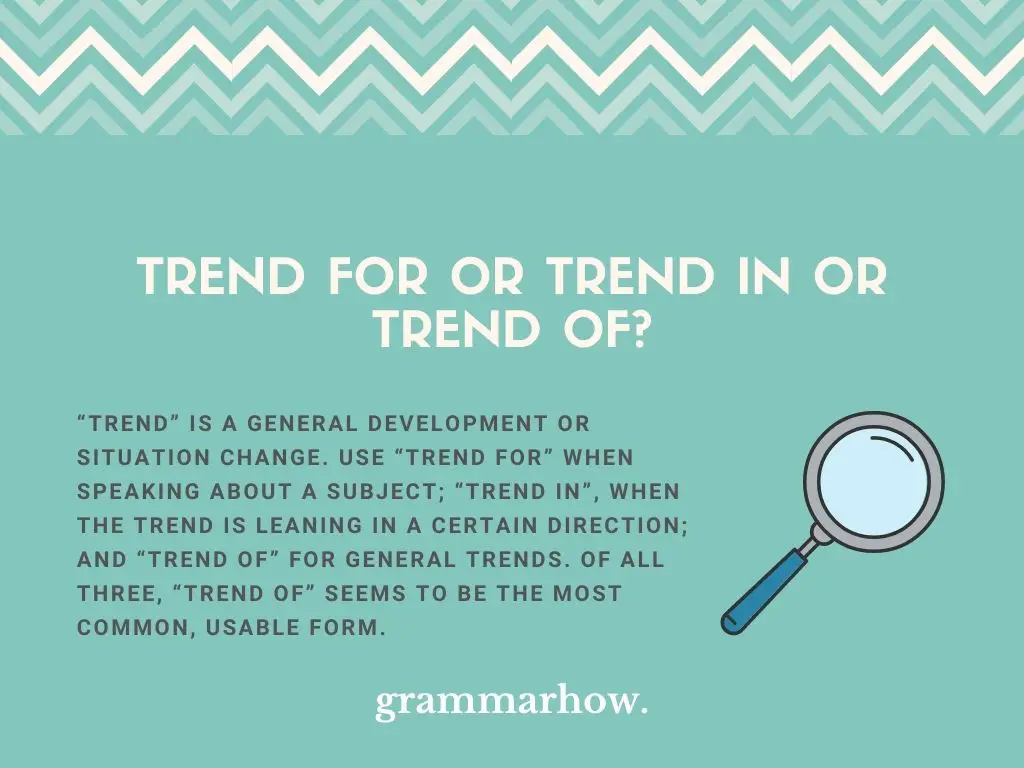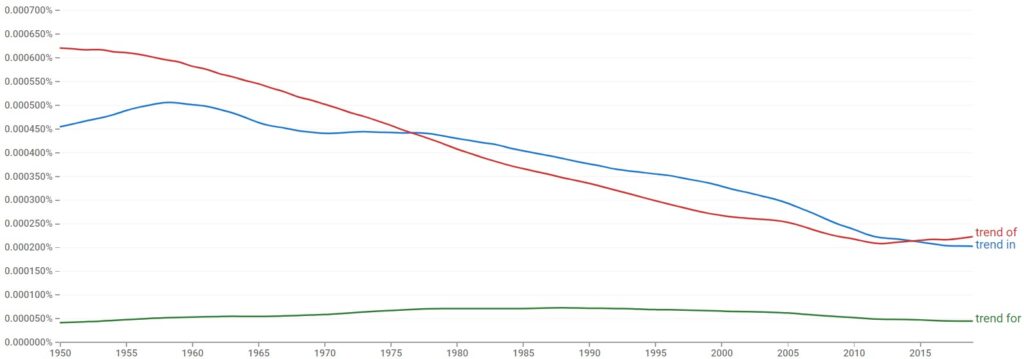“Trend” is quite a buzz word right now. People are using it in different contexts, and different scenarios. How can we join in and use the word “trend” without making any mistakes?
Can we say “Trend For”, “Trend In” and “Trend Of” and still get it right everytime? Let’s investigate!
Trend For or Trend In or Trend Of?
“Trend” is a general development or situation change. Use “Trend For” when speaking about a subject; “Trend In”, when the trend is leaning in a certain direction; and “Trend Of” for general trends. Of all three, “Trend Of” seems to be the most common, usable form.

Keep in mind that “Trend” is a versatile word that works well with many prepositions. Does it sound complicated? Let’s start with some examples, before we move on.
- The trend in blogging is to create as much content as possible.
- The trend of blogging is to create as much content as possible.
- The trend for bloggers is to create as much content as possible.
- The trend of bloggers is to create as much content as possible.
As you can see by the example, all three forms work fine, with some minor adjustments to make sure they’re grammatically correct.
The first sentence uses “Trend In”, meaning “the trend in (the field of) blogging”. In this sentence we’re discussing the direction a whole industry is going. It talks about the blogging industry as a whole. We interchanged “Trend In” for “Trend Of” in sentence two, and it worked just as fine.
The third sentence uses “Trend For”. It works, because it refers to the bloggers, as individuals (not the blogging industry in general). It addresses where the trend is taking those people. In sentence four, we interchanged “Trend For” for “Trend Of” and it still worked quite well.
As you can see, “Trend Of” seems to work well in both cases.
Trend For
“Trend For” relates to a trend for a subject. The preposition here is more connected to the subject of the sentence than the word “trend” itself. “For” means many things, but in this scenario it carries the idea of “in relation to” – in other words, “the trend in relation to”.
Let’s take a look at some examples, to clarify the concept of “Trend For”:
- The trend for some commodities is to continue to increase in price.
- The trend for content creators is to be as open as possible about their lives.
- After the pandemic, the trend for the workforce became to demand better pay.
- Since 2020, the trend for the holiday season has been to stay home, with family.
- Have you researched the trend for our company, for the next three quarters?
In every sentence of the example, “For” indicates and emphasizes the topic of the conversation. Be it commodities, an attitude, a group of people, “Trend For” makes it crystal clear that we’re talking about those issues specifically, and not in general.
For example, sentence 1 talks about some commodities, but all commodities market. Likewise, sentence 5 refers to a research about a company, not a whole industry.
Trend In
“Trend In” is used to indicate what something is inclining towards. In other words, in which direction an industry or concept is going. It’s not as connected to an individual subject (as we saw for “Trend For”). It brings information with a broader concept.
Let’s take a look at some examples:
- The trend in fashion is to create more non-binary items.
- Whatever is the trend in your industry now, it will likely become the norm in the future.
- After Covid-19, the trend in travel is to go places where you can remain isolated.
- Inflation is causing a trend in prices that seem to be constantly increasing.
- A trend in education is to do as many online courses as possible.
Unlike “Trend For” that focuses on a small sample of people (or things), “Trend In” helps us make generalizations. Right or wrong, “Trend In” shines a light on a general group, such as an industry, a profession, etc.
It’s possible that if we consider a subgroup inside this general field, the “Trend For” this subgroup could be more specific or even different. But that’s not the idea here. “Trend In” works better for generalizations and general ideas.
Trend Of
“Trend Of” can be used for both general trends and specific trends about groups and individuals. It indicates where the subject is leaning towards and where they are headed as a collective. “Of” frequently relates to the idea of possession, and that’s what “Trend Of” indicates.
Let’s take a look at some examples:
- The trend of this whole industry is to keep growing for many years.
- We must be diligent, if we want to keep this company’s trend of growth.
- The trend of this generation is to seek more fulfilling jobs, and do what makes them happy.
- Following the trend of social media, everyone is scared of being canceled.
- The trend of society is to become less conservative, as time goes by.
Which Is Used the Most?
Which one of the three forms, “Trend For”, “Trend In” or “Trend Of”, is used more often? Let’s find out by looking at the graph from Google Ngram Viewer below.

“Trend For” is the least used of the three – perhaps because it should be used to talk about subjects that do not necessarily reflect the whole general group.
“Trend Of” is the most used as of now, but it has been changing places with “Trend In” throughout time. “Trend In” was the most used before, and may be the most used again eventually.
We think it’s safe to say that both “Trend Of” and “Trend In” share the top spot for those expressions we’re looking at today.
Final Thoughts
The difference between “Trend For”, “Trend In” and “Trend Of” is slim, and they sometimes interchange. Use trend for when your focus is on the subject, not the trend. “Trend In” should be used when there’s an inclination, as direction the trend is going. Use “Trend Of” for general trends.

Martin holds a Master’s degree in Finance and International Business. He has six years of experience in professional communication with clients, executives, and colleagues. Furthermore, he has teaching experience from Aarhus University. Martin has been featured as an expert in communication and teaching on Forbes and Shopify. Read more about Martin here.

